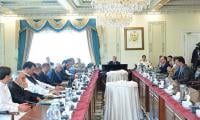The menace of twin deficits – the fiscal and current account deficits (seven and six percentage of GDP respectively) – will keep the federal government on its toes this year (2019) too.
After paying the provincial share of revenue from the federal divisible pool, the federal government is left with barely enough to meet two non-discretionary expenditures – debt retirement including mark-up payment, and the defence budget. In order to run day-to-day governance (salaries and pensions of the civil service) and to fund the developmental budget of the PSDP (the only discretionary expenditure), it relies on loans or external assistance. New loans are taken to pay off old ones.
After exhausting all options, the governments have to go to the lender of the last resort, the IMF. An IMF programme brings macro-economic stability at the cost of economic growth, which in turns further widens the income-expenditure gap; and the vicious debt cycle to manage the resultant fiscal deficit continues.
The PTI government is trying to come out of this debt trap. Although it is resisting the temptation to go to the IMF for another macroeconomic stability programme, it will find the fiscal deficit becoming unmanageable and will have to take some unpopular economic measures, which is usually what comes with any IMF programme.
During 2018, the political transition year, Pakistan’s economy became victim to larger political economy considerations. We saw a relaxation of Rs150 billion to individual tax payers by the Abbasi government in the run up to the elections; a Rs140 billion loss of revenue from the telecom sector under the orders of the higher judiciary; and a Rs100 billion loss to the revenue due to successive governments (PML-N- caretaker and the PTI) not implementing (or fully implementing) Ogra’s recommendations to increase the prices of petroleum products which then got translated into a fiscal deficit of slightly more than one percent of GDP. Here it must be kept in mind that in December 2018, global oil prices have declined to 50 dollars per barrel. A resultant reduction in domestic oil prices would further add to the fiscal deficit.
With or without an IMF programme, the government will have to increase tax collection. In first five months of this fiscal year, it could only collect Rs1200 billion. To meet its budgetary target of Rs4300 billion, it will have to collect another Rs3100 billion in the next seven months. This comes to Rs443 billion per month for the next seven months. To reduce the energy circular debt, the government will have to pass on to the consumers not only the cost of generation, but transmission and distribution losses and the capacity charges (mandatory payment to power plants, whether one buys from them or not) too – which means expensive electricity. On the spending side, the government would have to reduce its expenses by slashing down some of the projects (which are in the initial stages) from the PSDP.
One saw a substantial deprecation in the Pakistani rupee against the US dollar during the year 2018. Regulatory duties to discourage non-essential imports were also introduced last year. However, in the first five months of the current fiscal year, it only resulted in one percent increase in exports, whereas imports increased by three percent during this period. That simply means that the government will have to ‘do more’ (regulatory duties) to discourage non-essential imports.
The exchange rate of rupee versus the US dollar is quite close to its real effective value now. The positive news for 2019 is that, in order to improve Pakistan’s exports, instead of further depreciation of rupee, the government is likely to address the structural issues hampering our exports and give an export-friendly trade policy.
The depreciation in the rupee’s value would certainly turn into energy inflation if international oil prices go up. Besides oil prices, Pakistan’s economy in 2019 will depend on certain other external factors too.
For example, the geo-politics of the Middle East and the Gulf States and our relations with these countries (especially with Qatar and Iran in the context of the Saudi and UAE support for our balance of payments), and Pakistan’s relevance to the US after its decision of gradual withdrawal from Afghanistan (our relations with the US would define the IMF programme’s terms and conditions and tone).
There is also the matter of our relations with Europe (a major influence on the IMF’s executive board) and our preparedness to avail trade opportunities particularly in the UK and generally in Europe after Brexit. Then there is also the question of how prepared Pakistan is to avail export opportunities in China after the US-China trade war (for instance, US export of soybean to China amounts to $12.5 billion per year; any country that could supply soy to China can fill in this vacuum), and also industrial cooperation with China (which is ready to be a champion of clean and green growth after the recently-held COP24) under second phase of CPEC.
Among domestic factors, political stability, the pace of governance reforms, the security situation, the impact of climate change on our agriculture, and the successful implementation of forthcoming trade, industrial, and economic diplomacy policies would be decisive factors for Pakistan’s economy this year.
The bad news is that on the economic front 2019 will be equally painful for the government as well as the people of Pakistan. IMF or no IMF, the government’s attempts to tackle the fiscal and current account deficits, the reduced cotton production, the double digit discount rate, and the erosion in buying power due to currency depreciation will not only hurt the masses but also its own political capital.
However, the good news is that if the government wholeheartedly implements the apparently unpopular but extremely crucial economic-reform agenda, it will be in a position to heal the chronic wound hurting Pakistan’s economy. Imagine a Pakistan with no circular debt liabilities and no loss-making public-sector enterprises. Imagine a Pakistan where the tax-to-GDP ratio exceeds 20 percent, and where doing business is much easier and a lot cheaper than regional competitors. Only in that Pakistan can social sector expenditures be non-discretionary and debt retirement a discretionary expense.
We may not see such a Pakistan in 2019, but the PTI government should certainly aim for such a ‘Naya Pakistan’ within its remaining tenure. Otherwise, this country will suffer from a triple deficit menace – the third one a ‘trust deficit’ between the people and the government. To my knowledge, there is no IMF that can bridge that deficit.
The writer heads the Sustainable Development Policy Institute.
Twitter: @abidsuleri
People stand in line up as election officials check their ballot papers during voting general election at a polling...
Women show their voter identity cards as they stand in a queue before casting their votes in Agartala. — PTIThe 18th...
Former prime minister Imran Khan. — Instagram/ imrankhan.ptiAn old saying has it that “when you dance with the...
Kashmiris in Indian illegally occupied Kashmir protesting against the Indian occupation as the forces of India looked...
A representational image showing residents walking at a wholesale market in Karachi. — AFP/FileOnce again there is...
A representational image showing late Pakistani human rights activist and Supreme Court lawyer Asma Jahangir. —...







